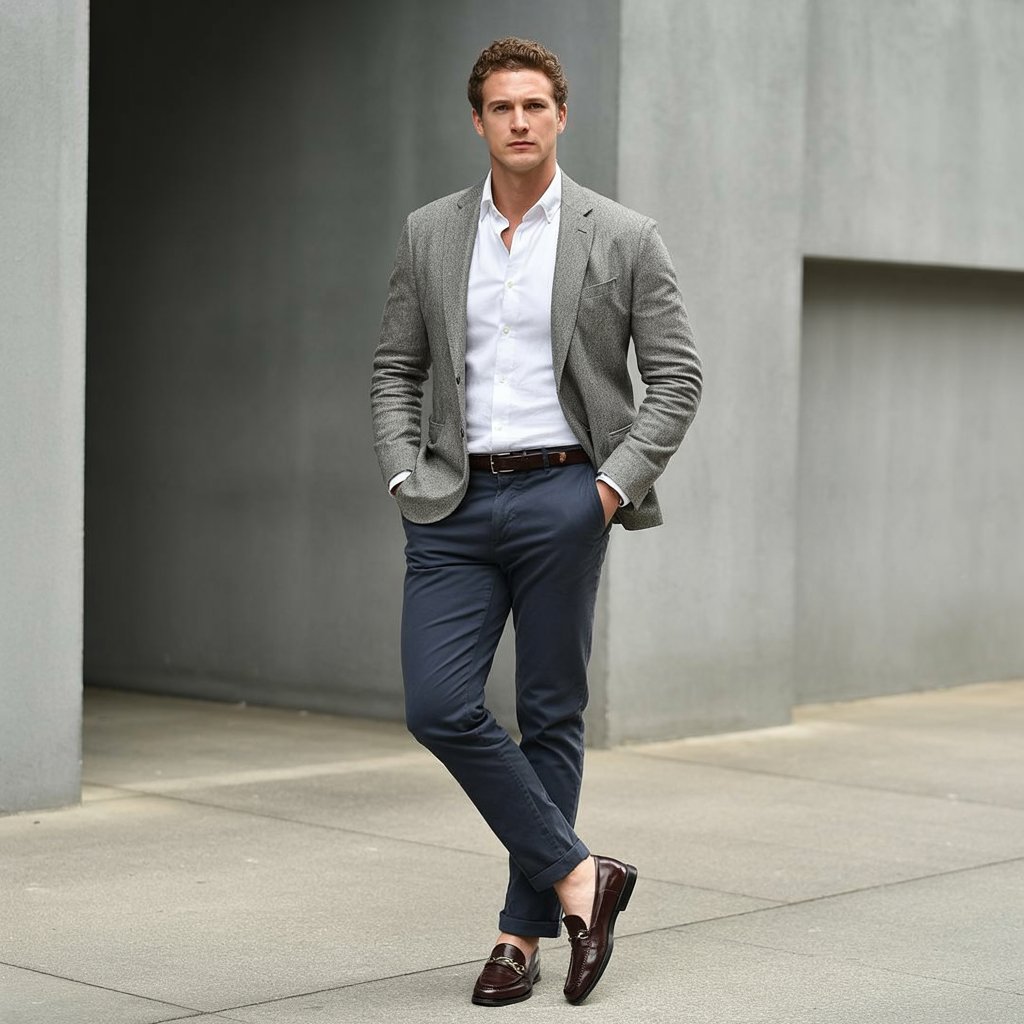Smart casual is the Goldilocks of men’s fashion—not too formal, not too relaxed, but just right. Yet, striking this balance can feel like navigating a minefield. Whether you’re heading to a casual office, a dinner date, or a weekend event, mastering smart casual ensures you look polished without sacrificing comfort. This guide breaks down the essentials, from wardrobe staples to styling hacks, helping you nail this versatile dress code every time.

1. Understanding Smart Casual: The Basics
Smart casual blends structured, tailored elements with relaxed, everyday pieces. Think of it as a middle ground between a suit and jeans-and-a-tee. The goal is to project sophistication while maintaining approachability. For instance, pairing a crisp button-down shirt with dark denim or chinos exemplifies this balance.
Key to nailing smart casual is understanding context. A tech startup’s interpretation might lean toward minimalist sneakers and unstructured blazers, while a creative agency may embrace bold patterns and textured fabrics. Always consider the setting—when in doubt, aim for subtlety over flashiness.
Pro Tip: “Smart casual is about intentionality. Every piece should feel deliberate, even if it’s casual.” – Alex Costa, Men’s Style Influencer
2. The Foundation: Building a Versatile Wardrobe
A smart casual wardrobe thrives on versatility. Invest in high-quality basics that mix and match effortlessly. Neutral colors like navy, gray, olive, and beige form a timeless palette, while textures (think cotton, linen, or tweed) add depth.
| Essential Item | Purpose | Example |
|---|---|---|
| Tailored Blazer | Adds polish | Unstructured linen blazer |
| Dark Denim | Casual edge | Slim-fit black jeans |
| White Oxford Shirt | Versatile layering | Non-iron cotton shirt |
| Chinos | Smart-casual staple | Olive tapered chinos |
Pro Tip: Start with 2-3 neutral blazers and pants. These anchor countless outfits, from office meetings to weekend brunches.
3. Shirts and Tops: Striking the Balance
The right shirt elevates smart casual instantly. Opt for:
- Button-Downs: Oxford cloth or pinpoint cotton for texture.
- Polo Shirts: Choose fitted styles in muted tones.
- Knits: Lightweight merino wool sweaters for layering.
Avoid overly casual graphic tees or stiff dress shirts. A rolled-sleeve linen shirt paired with tailored trousers strikes the perfect balance. For cooler months, layer a crewneck sweater over a collared shirt.
Pro Tip: “A well-fitted shirt is the backbone of smart casual. If it bunches or gaps, tailor it.”
4. Bottoms: From Chinos to Tailored Trousers
Your choice of bottoms sets the tone. Chinos reign supreme in smart casual—opt for slim or tapered fits in neutral hues. Tailored trousers in wool or cotton blends work for dressier settings, while dark denim (no rips or fading) keeps it relaxed.
Avoid:
- Baggy jeans or cargo pants.
- Overly formal suit pants (unless paired with a casual top).
Pro Tip: Cuff chinos slightly to showcase sleek footwear.
5. Footwear: Elevate Your Look with the Right Shoes
Shoes make or break an outfit. Smart casual demands styles that bridge casual and formal:
| Shoe Type | Occasion | Style Tip |
|---|---|---|
| Leather Loafers | Dressy events | Pair with no-show socks |
| Chelsea Boots | Fall/Winter outfits | Suede for texture |
| Minimalist Sneakers | Casual Fridays | White or neutral tones |
| Derby Shoes | Versatile everyday | Brown leather for warmth |
Pro Tip: Match your belt to your shoes for a cohesive look.
6. Layering: Jackets, Blazers, and Sweaters
Layering adds dimension. A lightweight bomber jacket over a henley shirt keeps weekends sharp, while an unstructured blazer with a tee modernizes the look. For winter, swap blazers for chore coats or cashmere-blend cardigans.
Pro Tip: Stick to three layers max—overdoing it can appear cluttered.
7. Accessories: The Finishing Touches
Accessories inject personality without overwhelming:
- Belts: Slim leather styles in black or brown.
- Watches: Minimalist faces with leather/metal bands.
- Pocket Squares: Folded neatly for blazer pockets.
- Bags: Structured leather messengers or canvas totes.
“Accessories are the exclamation point of an outfit.” – Tim Gunn, Fashion Consultant
Pro Tip: Avoid novelty accessories (e.g., cartoon socks) in professional settings.
8. Avoiding Common Smart Casual Mistakes
Steer clear of these pitfalls:
- Over-accessorizing: Less is more.
- Ill-Fitting Clothes: Tailoring is key.
- Mismatched Formality: Don’t pair a tuxedo shirt with joggers.
- Ignoring Grooming: Unkempt hair or scuffed shoes ruin the vibe.
Pro Tip: When uncertain, mirror the dress code of the most polished person in the room.
9. Seasonal Adaptations: Dressing for Weather
Adapt smart casual to the climate:
- Summer: Linen shirts, lightweight cotton trousers, and espadrilles.
- Winter: Wool-blend trousers, turtlenecks, and ankle boots.
- Spring/Fall: Layer with field jackets or quilted vests.
Pro Tip: Invest in seasonless fabrics like merino wool for year-round versatility.
10. Putting It All Together: Outfit Ideas
Office Casual:
- Navy blazer + white Oxford + gray chinos + brown loafers.
Weekend Brunch: - Olive bomber jacket + charcoal henley + dark denim + white sneakers.
Dinner Date: - Black turtleneck + tailored charcoal trousers + Chelsea boots.
Pro Tip: Use Pinterest or Instagram to save outfit inspiration. For more ideas, explore our Smart Casual Lookbook.
Final Thoughts
Mastering smart casual is about blending confidence with intentionality. Start with quality basics, experiment with textures and layers, and refine your look based on the occasion. Remember, the goal is to look effortlessly put-together—not like you tried too hard. Ready to revamp your wardrobe? Check out our Ultimate Guide to Men’s Wardrobe Essentials for deeper insights.
By embracing these principles, you’ll transform smart casual from a dress code into a signature style.
